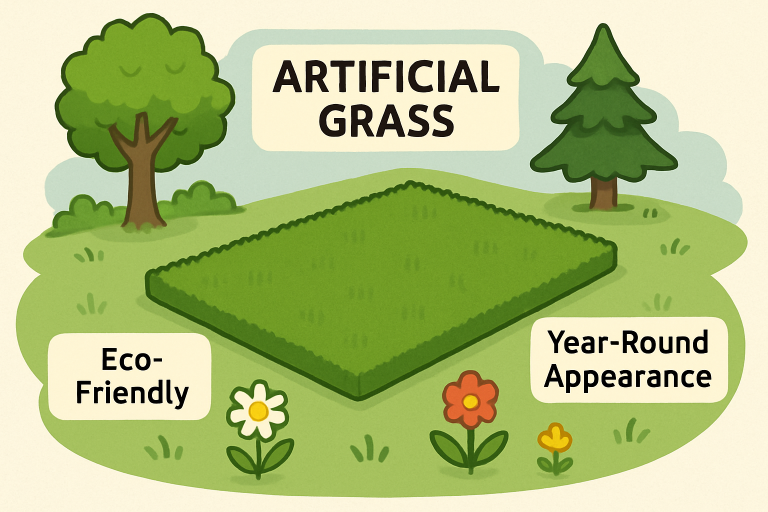Home Improvment
Sustainable Landscaping: The Role of Artificial Grass in Eco-Friendly Design

Creating eco-friendly outdoor spaces is becoming a growing priority for communities and businesses seeking to minimize their environmental impact. Among the innovative approaches gaining recognition is artificial grass, which can transform landscapes into low-maintenance, sustainable havens. For commercial landscaping projects, ForeverLawn of South Jersey provides tailored solutions that address both environmental and aesthetic concerns, offering a pathway to greener, more sustainable grounds. Artificial turf offers a sustainable alternative to traditional lawns by conserving water, reducing chemical use, and providing year-round greenery with minimal maintenance. Advances in recyclable and eco-friendly products further enhance their environmental appeal, making them a viable option for both residential and commercial landscapes. This article explores its sustainability benefits and offers tips for maximizing its ecological impact.
Water Conservation
Natural grass landscapes account for a significant portion of water consumption in residential and commercial settings, especially in drought-prone areas. Artificial turf systems significantly reduce this demand, as they require no regular watering to remain vibrant. According to the Environmental Protection Agency, landscape irrigation accounts for nearly one-third of all residential water use in the United States. Switching to artificial grass can save thousands of gallons of water each year per property, making it an effective solution in efforts to conserve this precious resource.
Chemical-Free Maintenance
Maintaining a green, weed-free natural lawn usually requires the application of fertilizers, herbicides, and pesticides. These chemicals can seep into the soil and enter rivers and lakes, harming aquatic life and affecting the quality of drinking water. With synthetic turf, there’s no need for chemical treatments, which helps reduce pollution and create a safer environment for families, pets, and local wildlife.
Reduced Carbon Footprint
Lawn mowers, trimmers, and other gas-powered landscaping tools are responsible for producing greenhouse gases and contributing to air pollution. Artificial grass eliminates the need for these machines, helping homeowners and property managers lower their carbon footprint. For large campuses, parks, and athletic facilities, the potential for substantial emissions reduction makes artificial turf an attractive option in the battle against climate change.
Durability and Longevity
Modern synthetic turf products are engineered to withstand heavy foot traffic, harsh weather conditions, and UV exposure without exhibiting significant signs of wear. Unlike natural grass, which can become patchy or muddy in high-use areas, artificial grass remains consistently green and uniform. This durability translates to a longer lifespan—often up to 15 years or more—reducing the need for frequent replacements and lessening the flow of waste to landfills. Durable landscapes also mean fewer disruptions for businesses and a better return on investment over time.

Allergen Reduction
Pollen, mold, and grass clippings are among the leading causes of outdoor allergies for both children and adults. As noted by Harlem World Magazine, artificial grass offers a refreshing alternative by creating a hypoallergenic outdoor environment and virtually eliminating many common irritants. This makes outdoor spaces more accessible and enjoyable year-round for individuals who are sensitive to allergens.
Versatility in Design
Artificial grass isn’t just for traditional lawns. Its adaptability allows it to be installed in spaces where natural grass would struggle, such as shaded courtyards, rooftop gardens, or heavily trafficked commercial areas. Designers can incorporate synthetic turf into creative landscape features, playgrounds, pet areas, and sports fields, creating green space where it would otherwise be impossible. This versatility is a key factor for urban planners seeking to reintroduce greenery in densely populated city settings.
Economic Benefits
While it’s true that the initial cost of installing artificial grass can be higher than seeding or sod, the long-term financial benefits are significant. Synthetic turf reduces or eliminates the need for watering and mowing, and eliminates costs associated with fertilizer and chemical applications. Maintenance typically involves only occasional cleaning or brushing. Throughout its life cycle, artificial turf can provide significant savings for property owners, particularly those responsible for extensive green spaces.
Addressing Environmental Concerns
Artificial grass can support sustainable landscaping by conserving water, reducing chemical use, and cutting maintenance emissions, but concerns remain over microplastic pollution and landfill waste. Choosing products made from recycled or recyclable materials with environmental certifications and working with eco-conscious providers can make it a more responsible choice.
